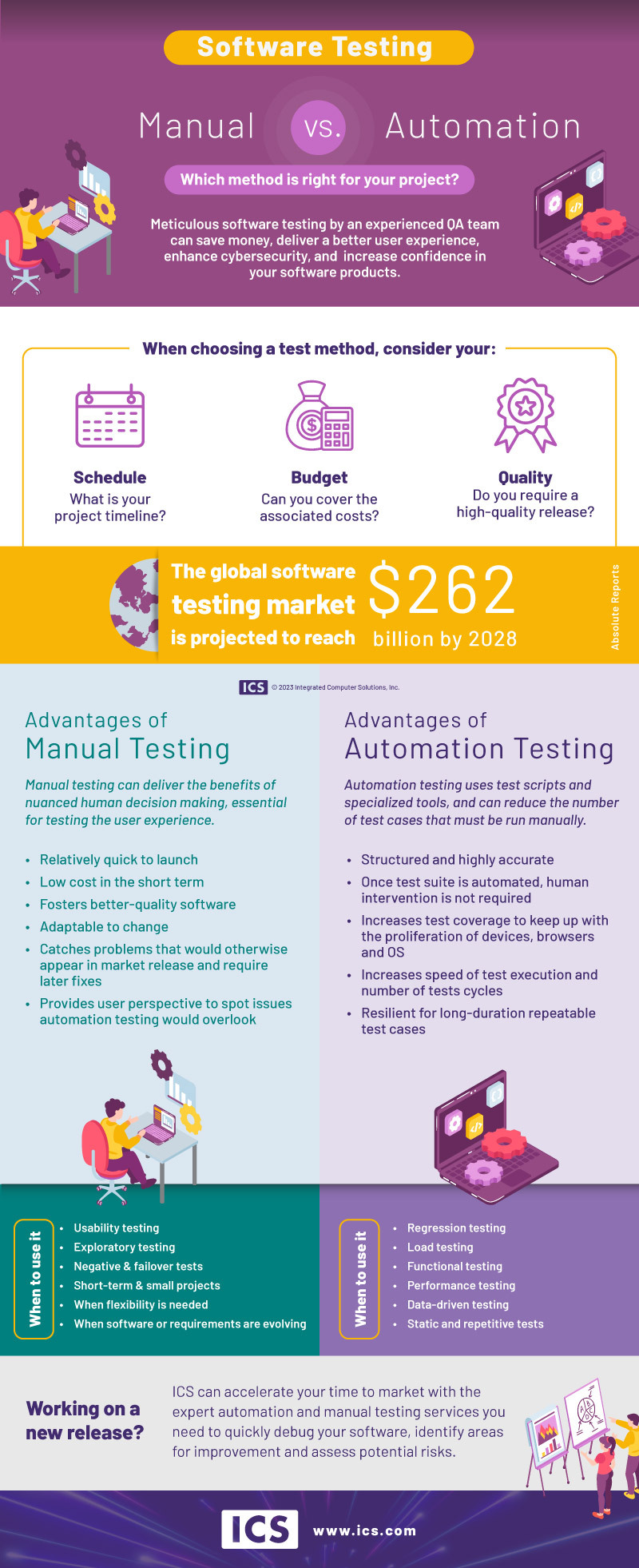
Which Software Testing Method is Right for Your Project?
The key to effective software testing is striking the right balance between automation and manual testing methods. Automation testing, in which the test case is executed by a tool rather than by a human, represents 80% of the software testing market according to Absolute Reports, in large part because it is highly accurate.
Still, there are many situations that call for manual testing. Though it may not always be as accurate as automation, the inclusion of human decision-making in the process provides greater flexibility. For certain types of tests, like usability testing, human testers can deliver more nuanced insight, which leads to improved software quality.
How do you know which method is appropriate for your project? Here’s a look at some of the pros and cons of each, as well as examples of when it makes sense to use each method.

Choosing the Best Method
Automation Testing
Automation Testing is performed using specialized testing software tools to execute a test case, enter test data into the system under test, compare expected and actual results, and generate detailed test reports. Automation can reduce the number of test cases that must be run manually.
Because humans are not involved in the process once the test is initially set up, organizations can perform more tests and significantly increase test coverage – good news in a world with a proliferation of devices, operating systems and browsers. Automation can also accelerate the release of new features, allowing companies to more quickly bring new products to market.
But automation testing requires substantial planning at the outset, which can be expensive and time consuming. For that reason, automation is not an optimal choice for short-term or small projects.
Pro
- Highly accurate
- Requires no human intervention (once the test suite is automated)
- Fast test execution
- Increased number of test cycles
- Resilient for long-duration, repeatable test cases
Con
- Expensive
- Resource-intensive
- Requires significant up-front planning
- Needs stable software and requirements
- Can’t capture nuance or handle ambiguity
- Can’t mimic the real-world environment in which product will be used
In 2022, 73% of testers use automation testing for functional and regression testing. (PractiTest)
When to use it:
- Regression testing
- Repetitive tests
- Data-driven testing
- Load testing
- Performance testing
Manual Testing
Manual testing is performed by an actual human, not a machine, executing the test steps. As such, it is a slower process than automation testing so fewer test cases and test cycles can be executed. But there are distinct benefits. First and foremost, it is less expensive than automation testing, making it a better choice for smaller (read: smaller budget) or short-duration projects. For some budget-sensitive organizations, automation testing – which involves costly test system planning and deployment, not to mention system maintenance – leaves manual testing as the only viable option in all cases.
There were more than 196,000 manual software testers employed in the US in 2022. (Zippia)
Beyond cost, where manual testing really shines relates to flexibility. If you’re developing new software or have new requirements – or have a project for which the software or requirements are evolving – manual testing is the only way to go. It allows for ad hoc testing and can adapt to your changing needs, something automation testing simply can’t do.
If your goal is to release better-quality software, essential for products such as medical devices, manual testing is the way to go as it affords the flexibility automation lacks. In the hands of experienced QA professionals, manual testing can identify even minute defects that automation would miss.
Pro
- Quick to start
- Low cost in the short term
- Adaptable to change
- Provides user perspective
Con
- Less accurate than automation testing
- Monotonous, which can lead to human error
- Inconsistent and difficult to repeat
- Time consuming and cost prohibitive to manually test all workflows and fields, especially as regression test cases grow
When to use it:
- Usability testing
- Exploratory testing
- When software and requirements are evolving
- Short-term projects
- Small projects
The Takeaway
The bottom line is this: though automation testing is more widely used than manual testing, each method has its place. By understanding the benefits and limitations of each and applying them appropriately, you can control costs while quickly deploying quality software.
Working on a new release? ICS can accelerate your time to market with the expert automated and manual testing services you need to quickly debug your software, identify areas for improvement and assess potential risks. Reach out to learn more.